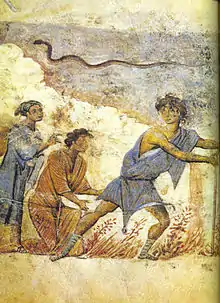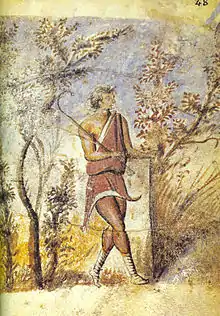Theriaca (poem)
The "Theriaca" (Ancient Greek: Θηριακά) is the longest surviving work of the 2nd-century BC Greek poet Nicander of Colophon.


It is a 958-line hexameter poem describing the nature of venomous creatures, including snakes, spiders, and scorpions, and the wounds that they inflict.[1]
Nicander also wrote the companion work Alexipharmaca, which explored other poisons and venoms.
Etymology
The title is the Latinized form of the Greek neuter plural adjective θηριακά (thēriaka), "having to do with venomous animals",[2] which in turn derives from Ancient Greek: θηρίον (thērion), "wild animal".[3] A corresponding English noun theriac also exists.[4]
References
- "Nicander of Colophon". University of Chicago.
- θηριακός. Liddell, Henry George; Scott, Robert; A Greek–English Lexicon at the Perseus Project.
- θηρίον in Liddell and Scott.
- "theriaca". dictionary.com.
Further reading
- Weitzmann, Kurt, ed., Age of spirituality: late antique and early Christian art, third to seventh century, no. 226, 1979, Metropolitan Museum of Art, New York, ISBN 9780870991790; full text available online from The Metropolitan Museum of Art Libraries
This article is issued from Wikipedia. The text is licensed under Creative Commons - Attribution - Sharealike. Additional terms may apply for the media files.